50+ Sample Interview Checklists
-
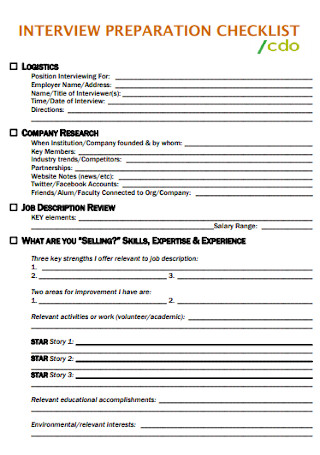
Interview Preparation Checklist
download now -
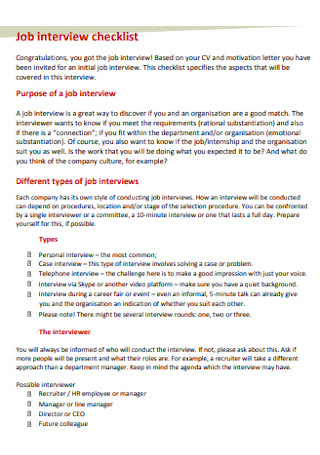
Job Interview Checklist
download now -

Phone Interview Checklist
download now -
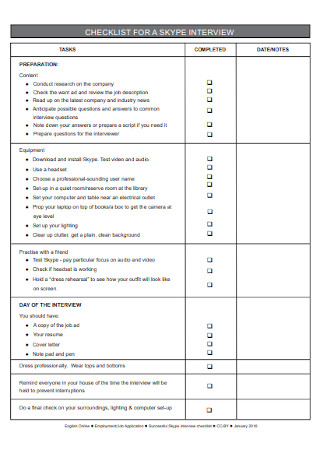
Checklist for Skype Interview
download now -
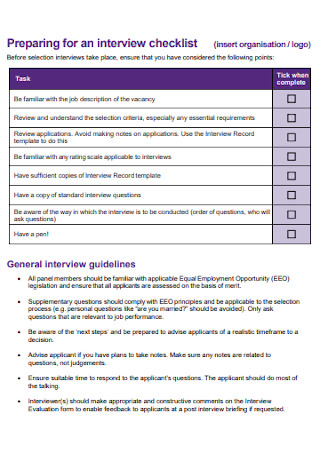
Preparation for an Interview Checklist
download now -

Simple Interview Checklist Template
download now -
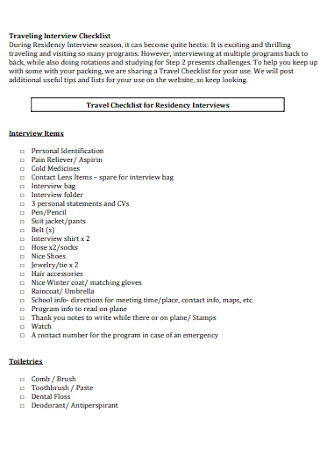
Traveling Interview Checklist
download now -
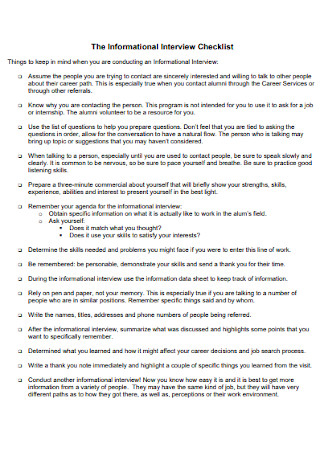
Sample Informational Interview Checklist
download now -
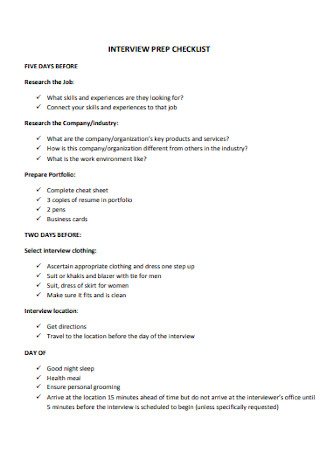
College Interview Preparation Checklist
download now -
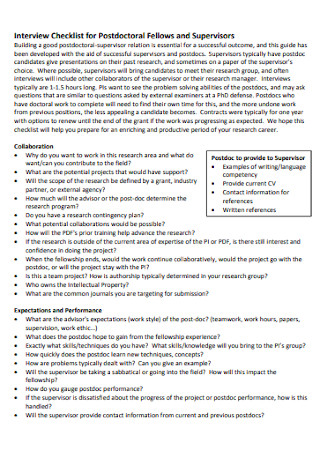
Interview Checklist for Postdoctoral Fellows
download now -

Inclusive Interview Checklist
download now -
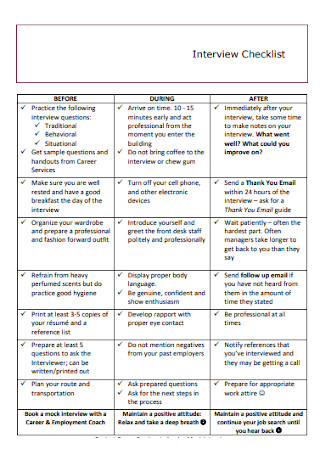
University Interview Checklist
download now -
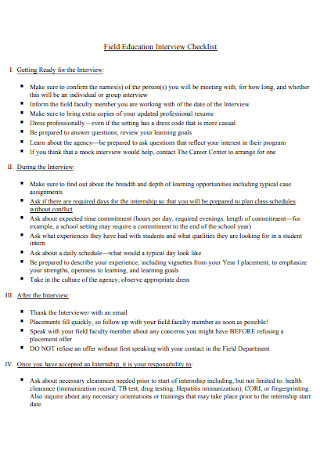
Field Education Interview Checklist
download now -
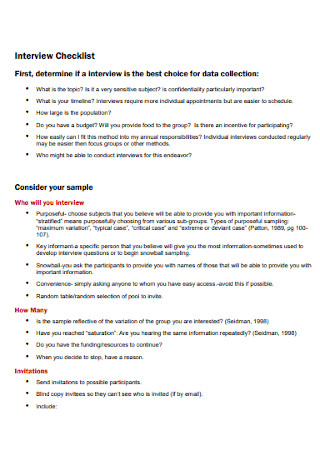
Student Interview Checklist Checklist
download now -

Candidate Interview Checklist
download now -
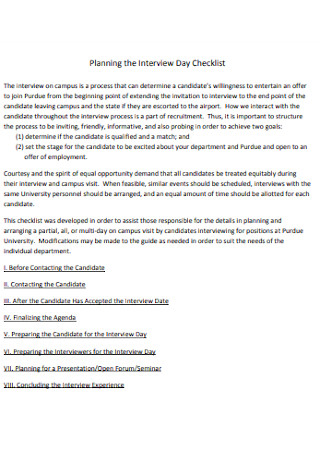
Interview Day Checklist
download now -
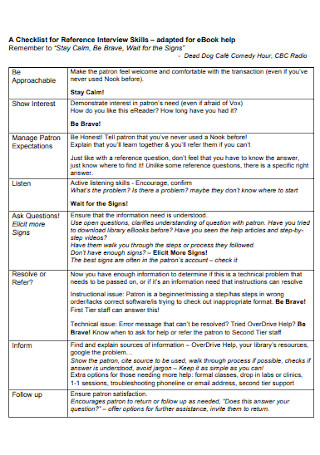
Checklist for Reference Interview Skills
download now -
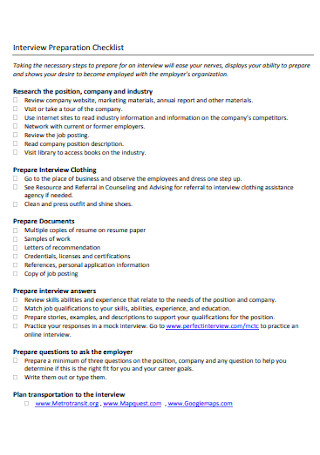
Interview Preparation Checklist Example
download now -
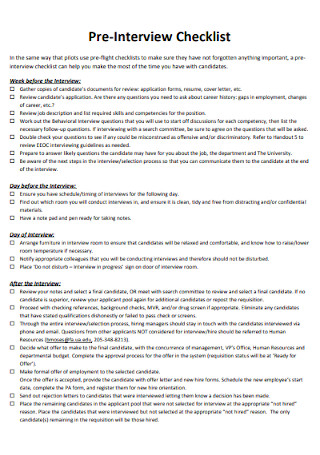
SImple Pre-Interview Checklist Template
download now -
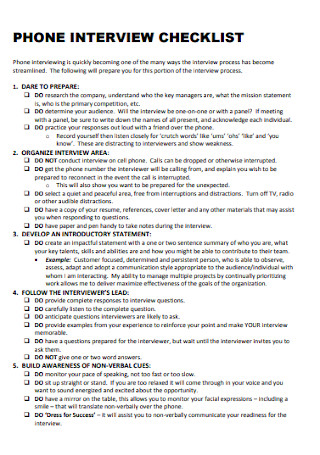
Phone Interview Checklist Template
download now -
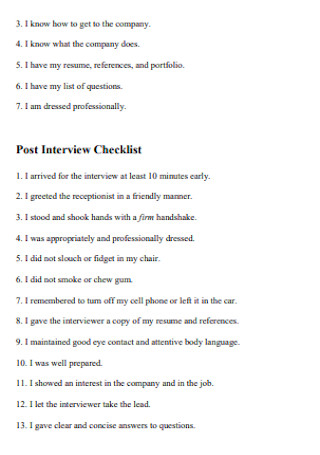
Post Interview Checklist Template
download now -
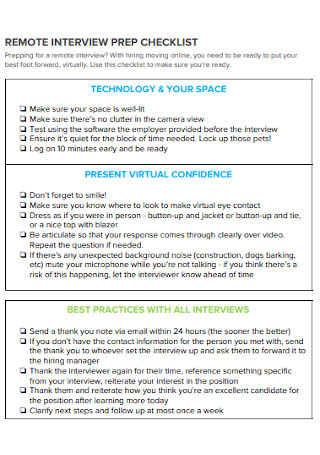
Remote Interview Checklist
download now -
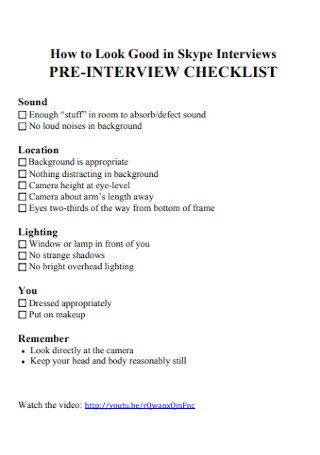
Skype Interviews Checklist Template
download now -
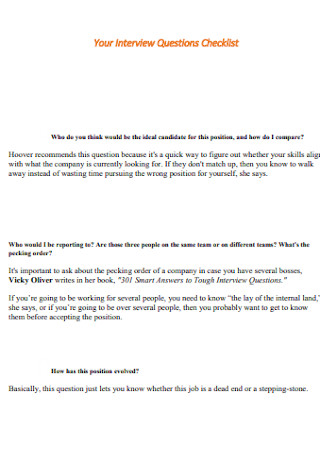
Interview Questions Checklist
download now -
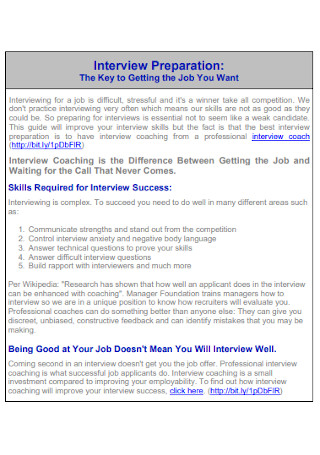
Interview Checklist for Job Seekers
download now -

Brown Interview Checklist
download now -
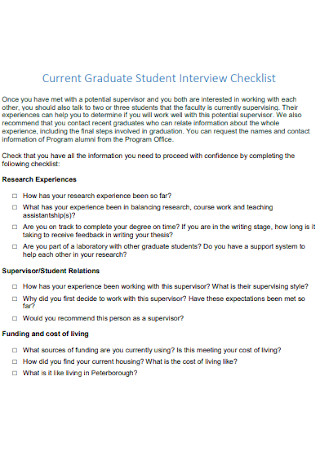
Graduate Student Interview Checklist
download now -
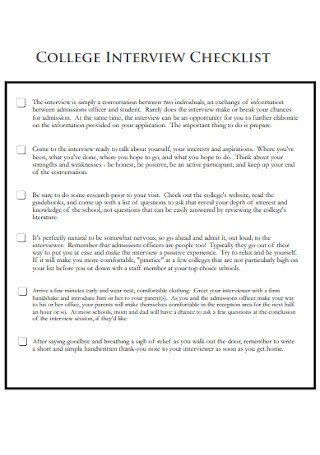
College Interview Checklist Template
download now -
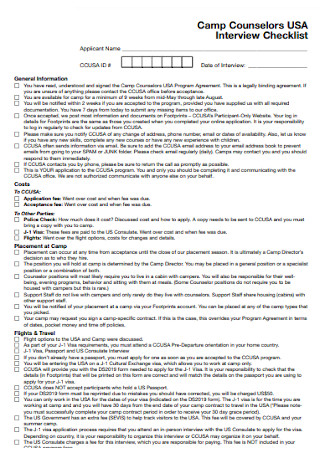
Camp Counselors Interview Checklist
download now -

Intake Interview Checklist
download now -

Media Interviews Checklist
download now -
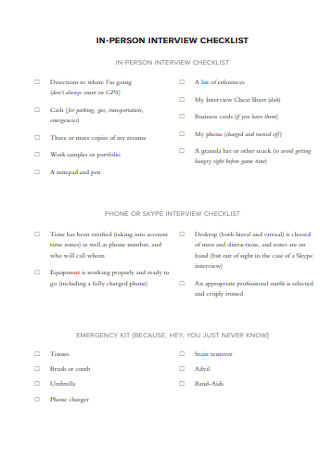
Person Interview Checklist
download now -
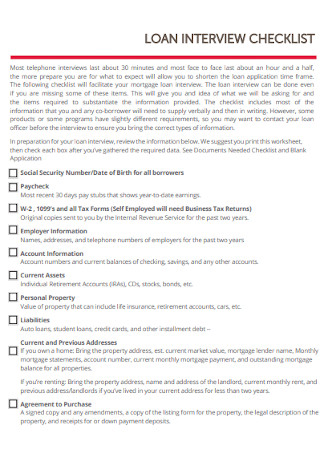
Loan Interview Checklist Template
download now -

Sample Screening Interview Checklist
download now -
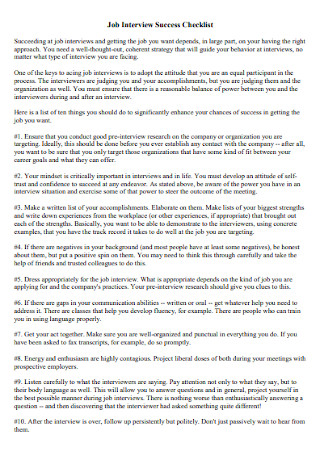
Job Interview Success Checklist
download now -
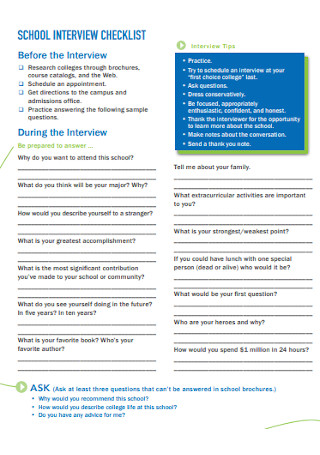
School Interview Checklist Template
download now -

Contextual Interview Checklist
download now -
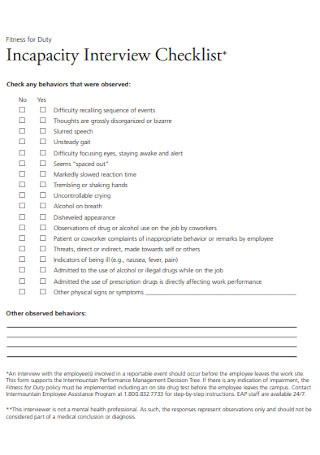
Incapacity Interview Checklist
download now -
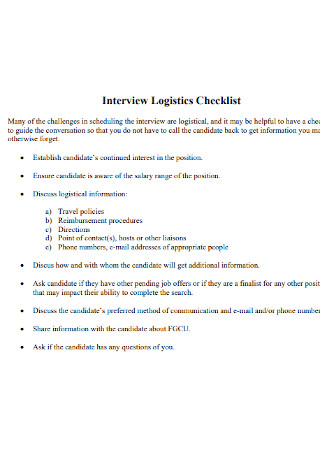
Interview Logistics Checklist
download now -
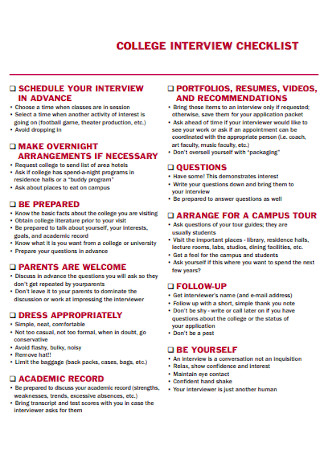
University of College Interview Checklist
download now -

Teacher Conference Interview Checklist
download now -

Checklist for Mock Interviews
download now -
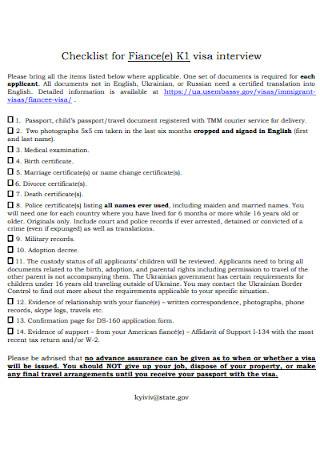
Checklist for Fiancé Visa Interview
download now -
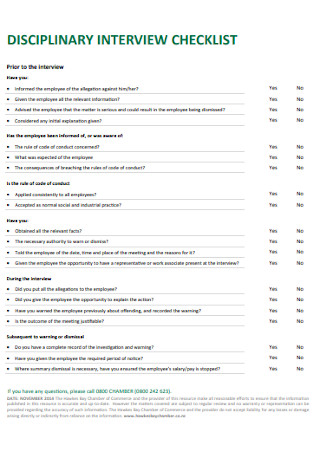
Disciplinary Interview Checklist
download now -
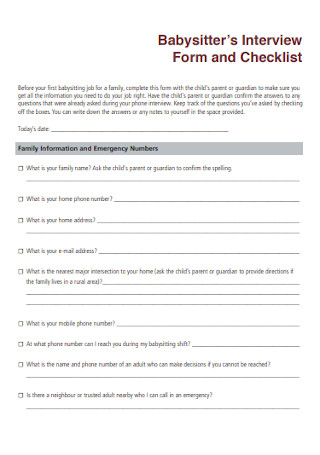
Babysitters Interview Form and Checklist
download now -
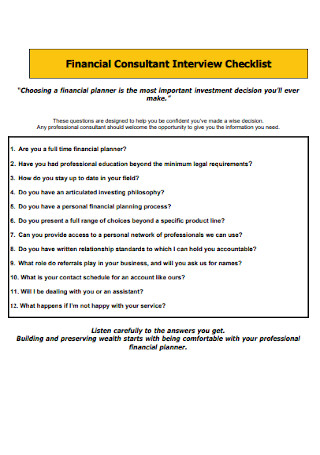
Financial Consultant Interview Checklist
download now -
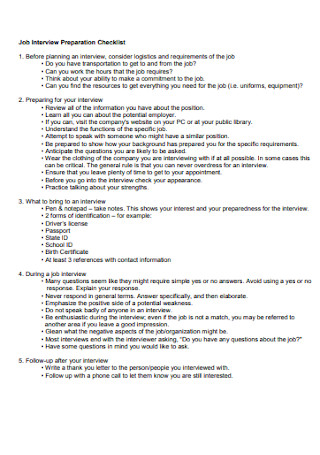
Job Interview Preparation Checklist
download now -
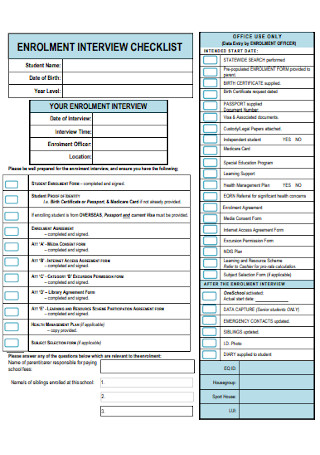
Enrollment Interview Checklist
download now -
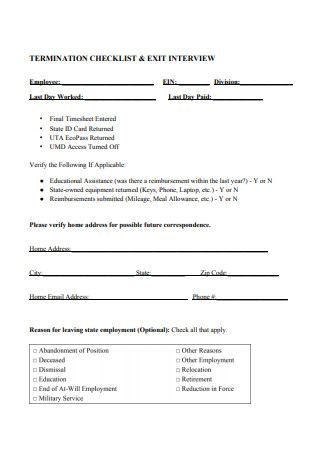
Interview Termination Checklist Template
download now -
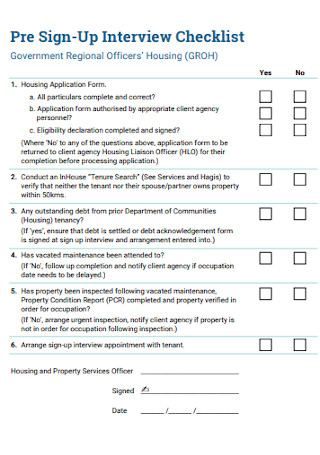
Pre Sign-Up Interview Checklist
download now -
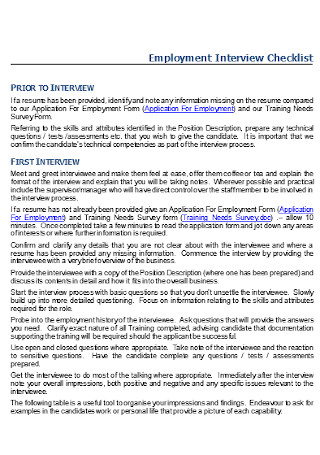
Employment Interview Checklist
download now
FREE Interview Checklist s to Download
50+ Sample Interview Checklists
What are Interview Checklists?
Must-Have Questions on Interview Checklists
How to Create an Interview Checklist
Improving the Interview Process Using the Checklist
FAQs
What goes on the interview checklist?
How many questions should you include on the interview checklist?
When do you have to think outside the boxes?
What are Interview Checklists?
An interview checklist for employers is an important tool used in the recruitment process of a company. It helps interviewers follow a guide and stick to important details about the job candidates that can be valuable for the company. Moreover, this can guide hiring managers to acquire talents that best fit the job and an interview checklist can help find top talents beyond what’s written on the resume.
As part of a recruitment plan, the interview checklists weeds out unqualified applicants and guide hiring managers in coming up with a great shortlist of job candidates. This also prevents regrets of hiring underperforming employees when managers spend more time managing underperformance.
Furthermore, when only good hires are onboarded, it prevents company losses as a poor hire is three times as much as the cost of a new hire. As a result, it improves employer branding and recruitment engagement, as well as enhances overall company work performance.
Interviewers have the skill to ask difficult questions and still make interviews seem to have an easy flow and make candidates feel comfortable. Although interviewers have a leeway to get creative with their questions, they still stick to general categories as an evaluation report tool of the candidate’s qualifications to see if they meet the hiring requisites. An effective interview is not easy to conduct. But there are things that you can do to prepare for it and make it more effective and worth your time. Use the guide below on how you can create your own interview checklist for employers and ensure that you are truly getting the good ones for the job.
Before any interview starts, it should be clear to you what you’re interviewing the applicant for by reviewing your pre-interview new hire checklist. Calibrate with other recruiters and team members about the interview process and ensure that all of you are aligned with the on-target questions to scan candidates for work, culture, and network fit. This allows you to come up with creative ways to keep job candidates interested in your company.
Furthermore, this allows you to review what hiring managers really want and not just to fulfill a requisition. So, you should take time to sit with the hiring manager and find out what they prefer to see in a candidate profile and work ethics.
An interview file is, in a way, a recruitment optimization folder that interviewers can use as an applicant reviewer as well as an evaluation tool kit. It should have all of the applicants’ information such as their resume, and scorecard so you only have one place to look when shortlisting candidates.
The scorecard is an important document that contains all the requisites that hiring managers want like candidates must possess leadership skills, teamwork, problem-solving attitude, time management, etc. This document is used as a reference guide on how interviewers can frame the interview as well as rank each applicant in every category requirements and promotes objectivity during the hiring process.
It is the recruiters’ and interviewers’ job to keep the interview interesting. To do this, they must craft interview questions that can draw out answers from the applicants and weed out candidates who only look good on paper but may lack the essential qualities needed for the job. Establish rapport with them so you can feel relaxed talking to them and comfortable enough to be truthful in their answers.
Do not forget about your hiring objectives and tie them into your interview questions. To avoid canned responses, steer clear from common interview questions and focus on asking behavioral and situational questions to reveal how candidates fit within the organization and how they react and address work-related scenarios.
These questions should also be able to bring out people who can also bring in new perspectives to the team while at the same time assess their skills that you’re looking for.
The interview checklist is only a guide, not a fixed structure. Keeping this in mind will allow you to try and experiment with the interview format that works best for you and the candidates while at the same time retain a sense of structure into your interview.
This means that you have leeway on how you can creatively ask the same predetermined questions to each candidate while maintaining a reliable discussion with the applicants. By doing this, you can stick to the objectives, assess candidates based on the same predictors of job performance, and not to mention, legally defensible and for better record-keeping.
Recruitment teams and hiring managers should also consider having a video interview checklist or virtual interview checklist as the hiring landscape changes because of the advancement of technology and globalization.
As far as record-keeping is concerned, your interview questions checklist should also have a section allotted for interview reviews and ratings. This allows candidates to assess the interview process and can help address weak points as they have noted.
This can be sent out as a short survey to the applicants after the interview but before the interview results are out. Through this process will help you determine room for improvement in your process as well as respond to them when they have a bad experience. Your response to a review alone is already a way of improving the applicants’ perception of the company.
Your interview checklist form should also include what to do after the interview. A post-interview checklist will ensure that candidates are informed about the status of their application to give them an idea of where they stand in the interview process–if it’s positive or negative. By keeping them posted, many great candidates are retained and will not be lost to other industry competitors due to recruitment indifference or delay.
Recruitment, like customer service, should treat every candidate they have like a customer. As many as 52% of job candidates find not knowing the status of their application to be frustrating and so they should not be left hanging just because the interview ended and. Candidates should have an idea about where their application stands from their initial resume submission to their interview appearance. This step is not only beneficial to the overall recruitment process perception but also helps in positive company engagement which can translate to brand dividends.
You have to admit that not all interviewers are great at what they do. But the good thing is that people can learn and improve their performance. Bear in mind that the interview process is only as strong as its weakest link.
Most interviewers who need coaching oftentimes wander off point and abandon the job interview checklist. They tend to ask inappropriate questions and monopolize the interview time instead of letting interviewers speak up. So, underperforming interviewers should be reminded to stick to the objectives of the interview by following the interview guide. This will streamline the process, and draw out more varied responses and lead to a more engaging interview experience.
Another way to help improve their performance is to consider sitting down with them beforehand to assess whether or not they have really understood the objectives and determine if they have prepared for the interview and have planned. In other words, you will be interviewing your interviewers. You can also tag-team or do group interviews rather than the standard one-on-ones, especially during the final interview.
For inexperienced interviewers, tough questions are difficult to ask. But they shouldn’t shy away from these questions–these are designed to assess how the candidate fits within the organization, the department, and the team.
Putting in the effort to make the job interview questions can actually help improve higher employee satisfaction. Most hiring managers want to work with the smartest and most creative people, but it is also important to consider looking for the best one who will fit in just right into the company culture. And asking these tough questions will help you easily identify just that.
Although interview checklists can be standardized, what you include in them depends on the hiring manager and the type of position you are trying to fill. The checklist for a managerial position is different from a rank and file one. The same way that the checklist for an accountant’s checklist is also different to that of a medical doctor’s even if they work in the same hospital. But employers should also make sure to ask standard questions that establish rapport.
Aside from these small talks, the checklist must cover a wide range of subjects that focuses on the job. The goal of the checklist is to elicit information that can be used to evaluate the candidate’s qualifications as well as allow them to expand their expertise, knowledge, and behavior.
If you take a look at different interview checklists for employers template, you will find that there is no exact number of questions on it. But it’s always a good idea to have both close-ended and open-ended questions as well as situational and behavioral questions. There should also be room to assess the candidates’ soft skills like critical and analytical thinking, and even conflict management and resolution.
However, the open-ended questions may take too much of your time, so make sure to keep an eye on the clock. Avoid long-winded answers by building a timeline into your checklist but also watch out that you don’t come off as dismissive of them. A good answer to one difficult question can tell you more about the candidate than to a dozen answers to simple ones.
Although there is an interview checklist for recruiters, good interviews are more than just ticking all the boxes on your list. Interviewers must be flexible enough to adapt to the interview flow while at the same time sticking to the interview guide. Interviewers are also encouraged to listen and observe just as much as they ask the questions.
For example, you can learn a lot about a candidate’s behavior plan if they came late or early to the interview, if they dressed appropriately or inappropriately, talk too much or talk less, or if they are combative or defensive, etc. Candidates who exhibit what generally is considered bad behaviors should be given a chance to explain themselves. They may be just nervous that’s why they talk too much or ask them for a reason why they came late to the interview.
There is no one-size-fits-all interview checklist template. It’s almost always flexible based on the interview. But the best thing about having one is that recruiters and hiring managers have a guide on what questions to ask that will address their objectives. An effective interview checklist is one step closer to hiring the right people that will improve organizational performance.
Must-Have Questions on Interview Checklists
How to Create an Interview Checklist
Step 1: Pre-Interview Team Huddle
Step 2: Create An Interview File For Every Job Applicant or Candidate
Step 3: Craft Effective Interview Questions Based on the Hiring Managers’ Requisites
Step 4: Try New Interview Formats
Step 5: Include Interview Reviews and Ratings From the Candidates
Step 6: Update the Candidates About the Status of Their Application
Improving the Interview Process Using the Checklist
Coach Poor Interviewers
Ask the Candidates Hard Questions
FAQs
What goes on the interview checklist?
How many questions should you include on the interview checklist?
When do you have to think outside the boxes?
